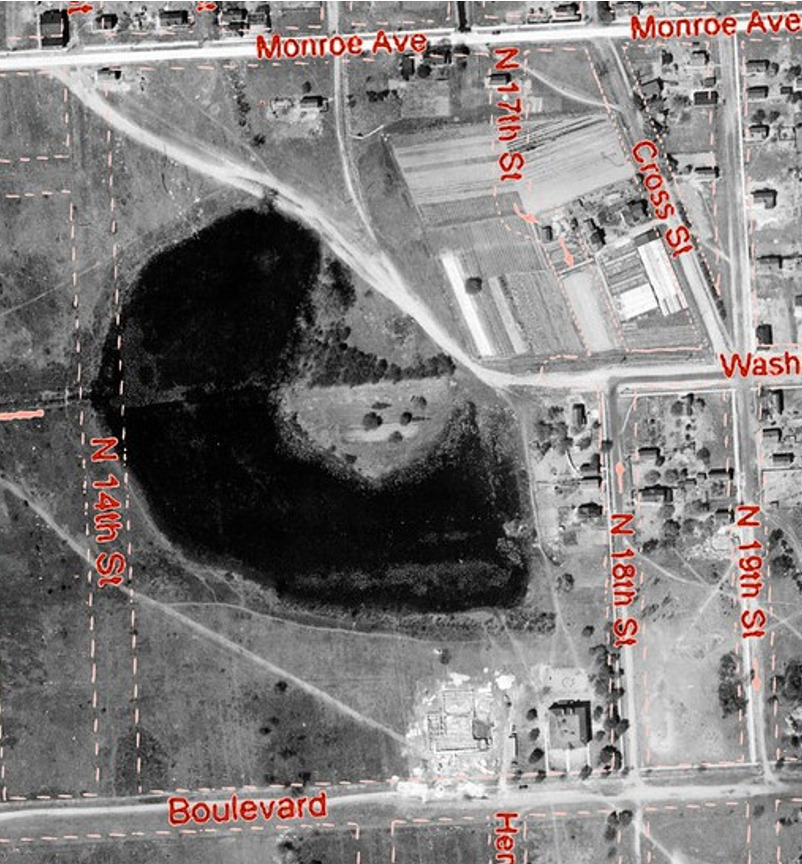
The ponds that disappeared, Part 3
The largest of Kenilworth’s three ponds that disappeared is Jackson Pond. It was somewhat kidney shaped and was, according to Charles Vitale (1921-2006), about nine to ten acres in size. It covered a large portion of today’s Brearley Middle-High School campus including the athletic field, much of the grass area along N. 14th St., and some of the parking lot.
Research suggests the pond was named for John Jackson who lived near the pond in the 1880s when that part of Kenilworth was in Cranford. He moved away after 1910. He lived on N. 16th St. south of Monroe Ave. where he operated a wood cutting factory and machine shop. He was elected Kenilworth’s first constable when the town was formed in 1907. Jackson left, but the name Jackson Pond remained.
Gene Coppola (1920-2020) noted that in his youth boys waded into the pond and gathered arms full of beautiful water lilies to sell in communities as far away as Newark and Morristown. Money earned augmented family incomes during the Great Depression. He told of wearing shoes in the pond so snapping turtles couldn’t bite his feet. Some sold turtles for 25 cents each to Berry Ausley, a luncheonette owner on Monroe Ave., who made turtle soup for patrons. Some hunted muskrats around the pond. Gene reported when boys got home, they rubbed baking flour on themselves to help remove leaches that were attached to their bodies.
Sal Cirillo (1929-2010) said it was a major winter ice-skating area noting the view around the pond was like a Currier and Ives Christmas card with skaters young and old out on the ice and others sitting at campfires along its banks. Frances Corcione Vardalis (1929-2022) told of people driving cars to the edge of the pond at night with headlights on to light up the pond.

In 1935 the pond was dredged of its gravel to be used on local roads. In 1945 the muck from the pond was sold for its potential value as topsoil and fertilizer. In 1953 plans for a dam were made to flood the pond in time for winter skating. From the inception of the Union County Pak Commission in the 1920s and into the1950s the pond area was eyed as a possible addition to the county park system. The mayor and council similarly were inclined to let it become a park. In 1956 the town made some grading improvements of the area to entice wider public use. Then things changed quickly. As interest grew to find a Kenilworth location for a regional high school, the administration of my late father, Mayor Walter E. Boright, Sr., set aside the Borough-owned acreage to preserve the site for a future high school, which fortuitously opened in 1966.
Construction of sanitary sewers in the 1920s that fractured the clay base beneath the pond is reported as one reason for its slow and persistent draining away. At some point in its life, a drainage ditch was dug from the pond at N. 14th St. west toward the Rahway River along the Washington Ave. right-of-way. In the 1950s, and during the years that followed, the ditch was piped and covered over. Open areas still exist from Wilshire Dr. westward to the river. In its final years as the water level ebbed and the pond grew smaller, it often was called “the swamp.” As plans for the David Brearley Regional HS accelerated in the1960s, what remained of the pond vanished as truckloads of fill dirt arrived. Only Shallcross Pond remains today off N. 14th St.
Research provided by Walter E. Boright, Ed. D., historian, and Historic Signs, Inc. The Cranford Chronicle archives provided some details. Persons with inquiries about this or other Kenilworth history topics may contact Dr. Boright atdrbori@aol.com or 908-256-5200.
